On Wednesday 19th August posted this 14th Case Study in a series looking at a single dispatch interval on Monday 15th October 2018 (one of 3 days through 2018 that saw a single instance of large* collective under-performance).
* with ‘large’ collective under-performance being measured as Aggregate Raw Off-Target across all Semi-Scheduled units being above +300MW.
This 15th Case Study today is a little different than the 14 which have come beforehand – because this Case Study (focused on 7th November 2018) is the first one to look at a day with more than a single instance of such a large collective deviation from aggregate Target. Over a 4 hour period on this day (11:00 to 15:00) there were 5 discrete instances:
(a) 4 instances of under-performance, and
(b) 1 instance of over-performance.
… and there were also a couple other dispatch intervals which were quite close to our 300MW threshold for ‘extreme’.
(A) Background context
Remember that we identified a total of 98 discrete instances where aggregate Raw Off-Target across all Semi-Scheduled units was either:
(a) above +300MW (representing collective under-performance) or, much less commonly,
(b) under –300MW (representing collective over-performance relative to AEMO’s expectations, seen in the Dispatch Target).
There was a smattering of only 10 cases through 2013, 2014, 2015, 2016, 2017 and through until August 2018. However thereafter (to the end of 2019) there was a sharp escalation of extreme incidents – as seen in the following chart:
Note also that we have not yet looked into 2020 data, which will be the focus of the GSD2020 (so we can’t comment on whether the trend from 2019 has continued to grow).
We’re doing this given a push from the AER Issues Paper, but moreso inspired by the deliberations by the (now defunct) COAG Energy Council and (extended?) ESB relating to ‘NEM 2.0’. Note that these case studies deal with imbalance in the Dispatch Interval timeframe, but readers should understand that there are other challenges that ‘NEM 2.0’ also needs to resolve, including:
Other Challenge #1) Within the dispatch interval timeframe, energy-related services focused on frequency maintenance and response to contingencies;
Other Challenge #2) Relating to ‘firmness’ of supply in the broader forecast horizon; and
Other Challenge #3) Others that we bundled into a ‘keeping the lights on’ services in our discussions in the Generator Report Card 2018 (for instance, in relation to System Strength).
In preparing these focused Case Studies, we’re seeking to understand why and what the implications are of this escalation. … so let’s look at this particular event:
(B) Summary over 4 Hours (11:00 to 15:00) on the day
Because there are 5 discrete instances of collective under-performance, we’ll start with this trend of the Aggregate Raw Off-Target value for the dispatch intervals in the four hour range from 11:00 to 15:00 on the day:
We see that 4 of these instances were collective under-performance, whilst 1 of these instances was over-performance (i.e. a negative aggregate Raw Off-Target).
I’ve also flagged two other dispatch intervals where the imbalance was up around 290MW – on in each direction.
(B1) Trended performance for all 61 DUIDs
Out of curiosity, I then layered on top of this chart the trended Raw Off-Target value for each of the 61 x Semi-Scheduled DUIDs which were operational on this day – it’s a busy chart, as a result of showing 62 discrete data series, so:
1) For most units I have coloured them green for wind and yellow for solar; but
2) A few particularly badly performing units have been highlighted, as they clearly stand out:
Keep in mind that the series for each of the Individual Raw Off-Target for 61 x DUID are shown on the LHS axis, which works out neatly as half the scale of the axis on the RHS, which shows the bars for Aggregate Raw Off-Target.
Observation #1) First and foremost what jumps out in this chart is what an awful performer Macarthur Wind Farm is by this ‘predictability’ measure of Raw Off-Target:
1a) Back on 28th January 2020 we named MACARTH1 ‘worst performer in the NEM’ of any DUID through 2019 using data compiled for the GSD2019 – and looking at trended results like this it’s not hard to understand why;
1b) The Raw Off-Target measure speaks to the predictability of output, with imbalances imparting a cost on the broader market. We see here that you’d have better odds on the roulette wheel than you would in predicting MACARTH1 output.
1c) The wind is ramping up and down across the day – dropping more than 200 MW at Macarthur from 377 MW at 12:30 to 132 MW at 12:45. The availability forecast is lagging. Same happened earlier in the day (11:45), and again at 13:50-13:55.
Observation #2) However the ‘blame’ does not solely lie with MACARTH1, as there are a handful of other DUIDs highlighted here whose deviations are more than 50MW on occasions.
2a) On some occasions we see that these deviations ‘help’ to keep the collective deviation lower; whilst
2b) On other occasions, we see they have an additive effect, on top of the massive deviations already presenting a challenge from MACARTH1, to drive collective imbalance to ‘extreme’ levels.
Remembering that it is the aggregate performance which is most important (shown in the bars above), given that this shows the level of imbalance which the NEM needs to address, a headline question seems to be …
Why* are the results so bad on this particular day … a number of times!
* amongst all of the >2,000 days that have elapsed for the Semi-Scheduled category prior to this point
We’ll try to answer this question in the analysis below of the 5 separate ‘extreme’ events…
(B2) Comparative performance for all 61 DUIDs
Taking the same performance stats (i.e. all 61 DUIDs over 48 dispatch intervals in the time range) we’ve then flipped the data to make the differences in performance more clearly:
Note that this 4 hour period was chosen just on the basis that the aggregate performance was particularly bad – so this need not specifically relate to the performance of any particular unit. Even just in this 4-hour time range, we’re only specifically focusing on 5 discrete dispatch intervals (i.e. of 48 in total) where the aggregate performance was bad.
However the chart above is a useful illustration of the scale of unpredictability of some of these Semi-Scheduled units.
For readers who want to review the individual performance of each of these units, along with all of the Scheduled ones as well, we included individual results for the whole of 2019 in the Generator Statistical Digest 2019, and will be updating these stats with data for 2020 in the Generator Statistical Digest 2020, which we plan to release in January 2021.
In this particular Case Study, we’re looking only at 4 hours in November 2018 – and in particular detail at only 5 x Dispatch Intervals in that range.
It’s worth reiterating that a useful way of thinking about the range of deviations shown here is that the NEM Rules were originally drawn up on the premise that any generator larger than 30MW would need to be Scheduled, because both:
1) AEMO would need visibility of their output; and
2) Would need to have its output Scheduled into the market.
The chart above shows deviations from Target which were not predicted by the AEMO. So for the DUIDs identified in the chart (which are most of the ones with deviations as large as 30MW, sometimes much larger) it’s like these generators (which the AEMO can see) also have a phantom/invisible generator at least 30MW in size coupled with it.
1) This phantom/invisible generator is acting unpredictably to produce these (net) deviations.
2) As noted here, it seems that the number of these phantom/invisible generators is growing, and that they are increasingly combining to produce major imbalances.
(B3) Quick notes about general conditions
Before we dive into the individual dispatch intervals, it’s worth highlighting a couple things:
(B3a) Negative Prices were not a factor
Prices were positive in all regions over this 4 hour period – hence the ‘not honouring the bid’ problem that was the topic of much of the AER Issues Paper is not a factor here. In fact, prices were quite healthy.
(B3b) Constraints were active
As you will see in the images below, there were constraints bound in various locations impacting on the output of some of the DUIDs highlighted:
1) the ‘S_NIL_STRENGTH_1’ constraint in South Australia, which seeks to wind down (or at least cap) the output of the Semi-Scheduled plant in South Australia; and
2) the ‘V::N_NIL_V2’ constraint in Victoria, which seeks to wind up the output of MACARTH1, ARWF1 and others
(B3c) Weather warnings?
The prior evening (Tuesday 6th November) there were storms that rolled through in several locations, leading to Non-Credible Contingency declarations by AEMO with respect to certain transmission lines. However that all pertained to the evening before, and there were no Market Notices issued that gave clues about weather related factors that might suggest the wild gyrations seen on the day…
(B3d) Broad coverage
Pay particular attention to the fact that these gyrations cover three regions (NSW, VIC and SA) and also involve both Wind Farms and Solar Farms (though to a lesser degree). Seemingly an illustration of challenges ahead.
(C) Taking a look at the 5 discrete dispatch intervals…
Walking through the results in chronological order for each of these 5 instances we will try to understand more of what was going on.
(C1) 1st ‘extreme’ event … +320MW (under-performance) at 11:45 on 7th Nov 2018
Here’s the same tabular framework of results for individual Raw Off-Target performance of all 61 x Semi-Scheduled units that were operational at the time:
In summary from this table, we can see the following:
1) Of the 61 DUIDs registered at the time, there are many more units under-performing (35 DUIDs) as there are over-performing (20 DUIDs).
2) Of the 35 DUIDs under-performing, two DUIDs are under-performing by more than 30MW (a threshold that is well in excess of the 6MW threshold used as an input for Conformance Status for a unit):
(a) Just these two units add to 221MW under-performance;
(b) However we should note that this still leaves an additional collective under-performance of 99MW (which is not a small number, in its own right).
(c) Much of this 99MW will have been delivered by the 8 additional DUIDs which showed Raw Off-Target above 6MW (some well into two digits), compared with a total of only 4 DUIDs under –6MW (only two of which were teens).
(d) This pattern (i.e. many more units under-performing than over-performing – and most considerably so) has generally been a pattern in these
3) We can see patterns that:
(a) The DUIDs showing large Raw Off-Target results are mostly in NSW and VIC, and
(b) Also that they are moreso Wind Farms than Solar Farms on this occasion.
Once again we use the ‘Unit Dashboard’ widget in ez2view (and the ‘Time Travel’ powerful rewind functionality) to review what some of the core stats were for this point in time for each of the units flagged as having significant Raw Off-Target.
(C1a) At 11:45 – White Rock Wind Farm in NSW (+54MW Raw Off-Target)
Here’s the snapshot from the WRWF1 unit:
We see a number of things in this snapshot:
1) A number of times previously on the chart (e.g. 10:00, 10:15 and 10:55) the output has dropped unexpectedly.
2) In terms of the 11:45 dispatch interval, the expectation was that the output would remain steady (i.e. 100MW to 107MW):
(a) However the unit unexpectedly dropped to 54MW at the same time.
(b) The Raw Off-Target value (107MW-54MW= 54MW) works out at the same, with rounding.
(C1b) At 11:45 – Macarthur Wind Farm in VIC (+167MW Raw Off-Target)
Here’s the snapshot of the MACARTH1 wind farm in this dispatch interval:
We see a number of things in this snapshot:
1) Output has been jumping up and down like a yo-yo;
2) The prior dispatch interval, the ‘V::N_NIL_V2’ constraint had been bound.
(a) Because MACARTH1 has a negative factor (i.e. –0.313) on this constraint equation, the constraint is seeking to ‘wind up’ the output, all else being equal
(b) Hence no Semi-Dispatch Cap (SDC).
3) In the 11:45 dispatch interval, the SDC flag comes on because the NEMDE seeks to dispatch as much energy as possible:
(a) But the 60MW maximum increase (from 209MW to 269MW) is limited by the +12MW ROCUP rate in the bid.
(b) This means Target of 269MW is well below the 292MW availability that AWEFS sees for the plant.
4) Unfortunately, instead of increasing, the unit drops over 100MW in output from 209MW down to 101MW…. hence the 167MW Raw Off-Target value which triggers the yellow alert colour in the table as it is so large.
(C1c) At 11:45 – Others
Notable mention should also go to GANNSF1 (+22MW Raw Off-Target) and SALTCRK1 (+28MW Raw Off-Target) and a couple others which showed under-performance greater than 10MW. These are significant deviations in their own right, though obviously not as large as the two above. No time to investigate in this (already long) Case Study.
(C2) 2nd ‘extreme’ event … +328MW (under-performance) at 12:45 on 7th Nov 2018
Here’s the same tabular framework of results for individual Raw Off-Target performance of all 61 x Semi-Scheduled units that were operational at the time;
In summary from this table, we can see the following:
1) Of the 61 DUIDs registered at the time, there are many more the number under-performing (34 DUIDs) as there are over-performing (22 DUIDs).
2) Of the 34 DUIDs under-performing, four DUIDs are under-performing by more than 30MW (a threshold that is well in excess of the 6MW threshold used as an input for Conformance Status for a unit):
(a) Just these four units add to 258MW under-performance;
(b) However we should note that this still leaves an additional collective under-performance of 70MW (which is not a small number, in its own right).
3) In this case, in terms of patterns:
(a) We see cells highlighted across NSW, VIC and SA – but the four bid deviations being in VIC and SA;
(b) Many more large deviations are Wind Farms than Solar Farms on this occasion.
Once again we use the ‘Unit Dashboard’ widget in ez2view (and the ‘Time Travel’ powerful rewind functionality) to review what some of the core stats were for this point in time for each of the units flagged as having significant Raw Off-Target.
(C1a) At 12:45 – Bald Hills Wind Farm in VIC (+47MW Raw Off-Target)
Here’s a snapshot of the ‘Unit Dashboard’ widget focused on BALDHWF1 at this time:
We see that the output of the plant has been bouncing significantly through the past 3 hours, particularly over the past hour or so. NEMDE asks for an increase in output, but instead the actual output ‘went the wrong way’ with a large down drop to 36MW. The combined difference means a Raw Off-Target of +47MW (i.e. under-performance).
Bald Hills (VIC) contributes 25 MW at 12:40 and 47 MW at 12:45, which looks like either a rapid wind change or a short spell of high wind cut-out – we don’t have the data to tell. Either way, the lagging forecast with rapid change in output gives the off-target result.
(C1b) At 12:45 – Macarthur Wind Farm in VIC (+124MW Raw Off-Target)
Here, once again, is MACARTH1:
The Raw Off-Target discrepancy was ‘only’ 124MW in this dispatch interval – which, whilst quite large (more than 4 times the threshold for being Registered) is still smaller than the prior interval. Talk about a stomach-dropping ride on a roller coaster!
(C1c) At 12:45 – Hallett 2 Wind Farm in SA (+50MW Raw Off-Target)
Here is HALLWF2:
The picture is a bit different here, in that the unit appears to have encountered some form of difficulty from around 12:20 with an unpredicted, but quite gradual, trip down to 0MW by 12:35. Was this the result of high-wind cut-out, or some other cause?
(C1d) At 12:45 – Hallett 4 ‘North Brown Hill’ Wind Farm in SA (+37MW Raw Off-Target)
Here is NBHWF1:
In this case, the net imbalance derives from the difference between an increase requested in the Dispatch Target and a reduction in output actually delivered. I don’t have time to explore this ‘went the wrong way’ example.
(C1e) At 12:45 – Others
Notable mention should also go to BROKENH1 (+20MW) and SAPH1 (+14MW) and ARWF1 (+15MW) and BLUFF1 (11MW) and HALLWF1 (+16MW) all adding to the collective under-performance. On the other side of the equation, there were several plants contributing two digits to keeping the total lower – being CROOKWF2 (-11MW) and GULLRWF1 (-10MW).
(C1f) Special mention of Bungala 1 Solar Farm
BNGSF1 actually does not contribute much to the imbalance in this particular dispatch interval. However I’ve thrown this in here as another illustration of a unit that’s all over the place through the morning, for unknown reasons (cloud cover?)
(C3) 3rd ‘extreme’ event … +333MW (under-performance) at 13:50 on 7th Nov 2018
Here’s the same tabular framework of results for individual Raw Off-Target performance of all 61 x Semi-Scheduled units that were operational at the time;
In summary from this table, we can see the following:
1) Of the 61 DUIDs registered at the time, there are many more the number under-performing (36 DUIDs) as there are over-performing (21 DUIDs).
2) Of the 36 DUIDs under-performing, three DUIDs are under-performing by more than 30MW (a threshold that is well in excess of the 6MW threshold used as an input for Conformance Status for a unit):
(a) Just these three units add to 237MW under-performance;
(b) However we should note that this still leaves an additional collective under-performance of 95MW (which is not a small number, in its own right).
3) There does not seem a specific pattern across the NEM in a glance down the table above.
Here are the headline units….
(C1a) At 13:50 – Gullen Range 1 Wind Farm in NSW (+48MW Raw Off-Target)
Here’s GULLRWF1:
Like some of the other snapshots shown in this case study, we see some fairly steep increases and decreases in output for this unit.
(C1b) At 13:50 – Ararat Wind Farm in VIC (+54MW Raw Off-Target)
Here’s ARWF1, which we see was ‘second worst’ to MACARTH1 over the 4-hour stretch above:
As like others, a roller coaster ride.
(C1c) At 13:50 – Macarthur Wind Farm in VIC (+135MW Raw Off-Target)
Here’s MACARTH1 for the third time today:
The roller coaster continues.
(C1d) At 13:50 – Others
Note the significant number of units lightly highlighted above as having Raw Off-target greater than 6MW. Particular mention goes to HALLWF2 (+26MW) as the ‘largest of the rest’.
(C4) 4th ‘extreme’ event … +371MW (under-performance) at 13:55 on 7th Nov 2018
Five minutes later, we hit an even larger level of imbalance – being 371MW, still an under-performance:
In summary from this table, we can see the following:
1) Of the 61 DUIDs registered at the time, there are many more the number under-performing (35 DUIDs) as there are over-performing (22 DUIDs).
2) Of the 36 DUIDs under-performing, three DUIDs are under-performing by more than 30MW (a threshold that is well in excess of the 6MW threshold used as an input for Conformance Status for a unit):
(a) Just these three units add to 296MW under-performance;
(b) However we should note that this still leaves an additional collective under-performance of 75MW (which is not a small number, in its own right).
3) There does not seem a specific pattern across the NEM in a glance down the table above.
Once again we use the ‘Unit Dashboard’ widget in ez2view (and the ‘Time Travel’ powerful rewind functionality) to review what some of the core stats were for this point in time for each of the units flagged as having significant Raw Off-Target.
(C1a) At 13:55 – Broken Hill Solar Farm in NSW (+33MW Raw Off-Target)
Here’s BROKENH1:
As with the Bungala Solar Farm illustrated above, the output here is just all over the shop. It just happens that this +33MW Raw Off-Target results coincides with the 2 worst offenders below to deliver the biggest result on the day.
(C1b) At 13:55 – Ararat Wind Farm in VIC (+99MW Raw Off-Target)
We note that the under-performance of ARWF1 has become almost twice as bad as in the prior dispatch interval (i.e. 99MW, up from 54MW):
ARWF1, somewhat nearby to MACARTH1, shows a wind gust ripping through and then disappearing again (hence a similarly lagging forecast). Also worth noting that the 14:00 dispatch interval also sees 78MW Raw Off-Target.
(C1c) At 13:55 – Macarthur Wind Farm in VIC (+135MW Raw Off-Target)
We note that the under-performance of MACARTH1 has become worse in this dispatch interval (i.e. 163MW, up from 135MW):
(C1d) At 13:55 – Others
Notable mention should also go to WOODLWN1 (+27MW) in NSW, GANNSF1 (+20MW) – another solar farm, and NBHWF1 (+19MW) in South Australia.
(C5) 5th ‘extreme’ event … –306MW (over-performance) at 14:40 on 7th Nov 2018
The fifth of the events on this day we’ll drill into was an instance (at 14:40) of collective over-performance. Pay careful attention in the table below of how many DUIDs (12 in total!) show notable over-performance in this instance:
In summary from this table, we can see the following:
1) Of the 61 DUIDs registered at the time, there are still many more the number under-performing (33 DUIDs) as there are over-performing (24 DUIDs).
(a) However there are 12 units significantly over-performing, and only 2 units flagged as significantly under-performing.
(b) Somehow, the balance has flipped!
2) Of the 24 DUIDs over-performing, two DUIDs are over-performing by more than 30MW (a threshold that is well in excess of the 6MW threshold used as an input for Conformance Status for a unit):
(a) Just these three units add to 296MW under-performance;
(b) However we should note that this still leaves an additional collective under-performance of 75MW (which is not a small number, in its own right).
3) There does not seem a specific pattern across the NEM in a glance down the table above.
–
Once again we use the ‘Unit Dashboard’ widget in ez2view (and the ‘Time Travel’ powerful rewind functionality) to review what some of the core stats were for this point in time for each of the units flagged as having significant Raw Off-Target.
(C1a) At 14:40 – Broken Hill Solar Farm in NSW (-34MW Raw Off-Target)
Here’s BROKENH1, still showing a wild ride:
(C1b) At 14:40 – Macarthur Wind Farm in VIC (-160MW Raw Off-Target)
This is another instance of large Off-Target for MACARTH1 – just in the negative direction:
Hold onto your hats, as the roller coaster blasts up the steep incline!
(C1c) At 14:40 – Others
Notable mention should also go to COLEASF1 (-29MW) and CROOKWF2 (-21MW) and ARWF1 (-26MW) and OAKLAND1 (-22MW) and SALTCRK1 (-25MW), which all over-performed by more than 20MW.
I noticed that GANNSF1 (+23MW) was the only under-performance in two digits which would have helped to keep the total down below where it would have otherwise been.
(D) Questions … but no clear Answers?
In the absence of other accessible information, the above data suggests some widespread storm front activity through the middle part of the day (lasting 4 hours and covering SA, VIC and NSW) which delivered wildly gyrating outputs on both Wind Farms and Solar Farms.
If this hypothesis is correct, then it would suggest that adding more Semi-Scheduled capacity to the mix on a day like today would mean magnifying the wild gyrations in aggregate under-performance and over-performance. The headline question posed right at the start of this series of Case Studies is:
What are the implications of this?
Is the solution ‘just’ massively expanding the volume of Regulation FCAS (and possibly Contingency FCAS) enabled, and allocating the costs of these to those who can’t predict/control their output?
… or is something more required?
Your thoughts, please?


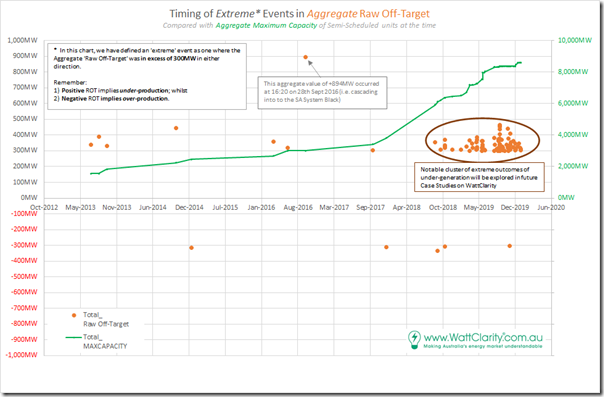
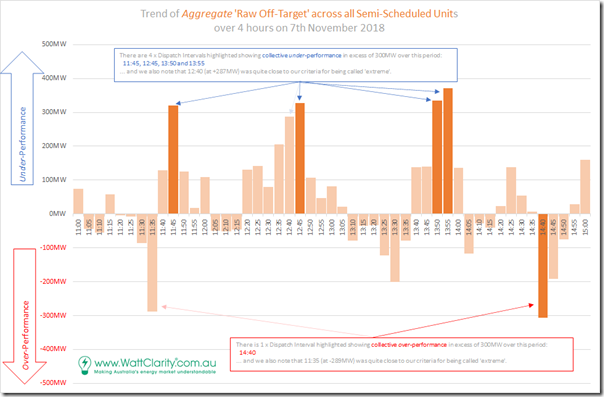
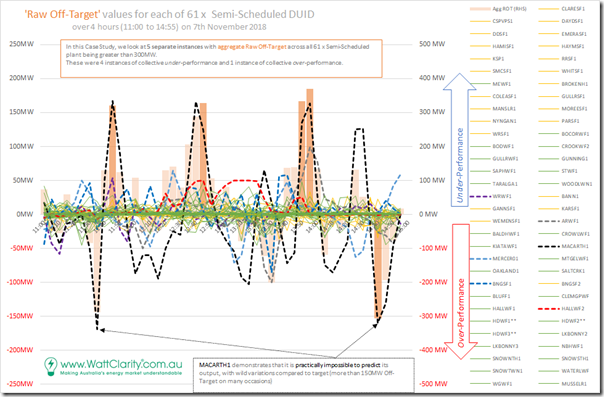
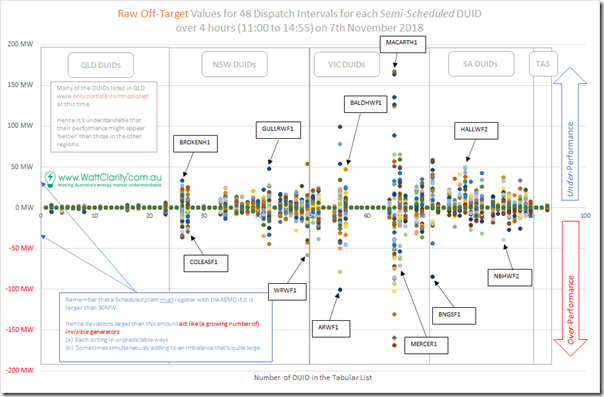
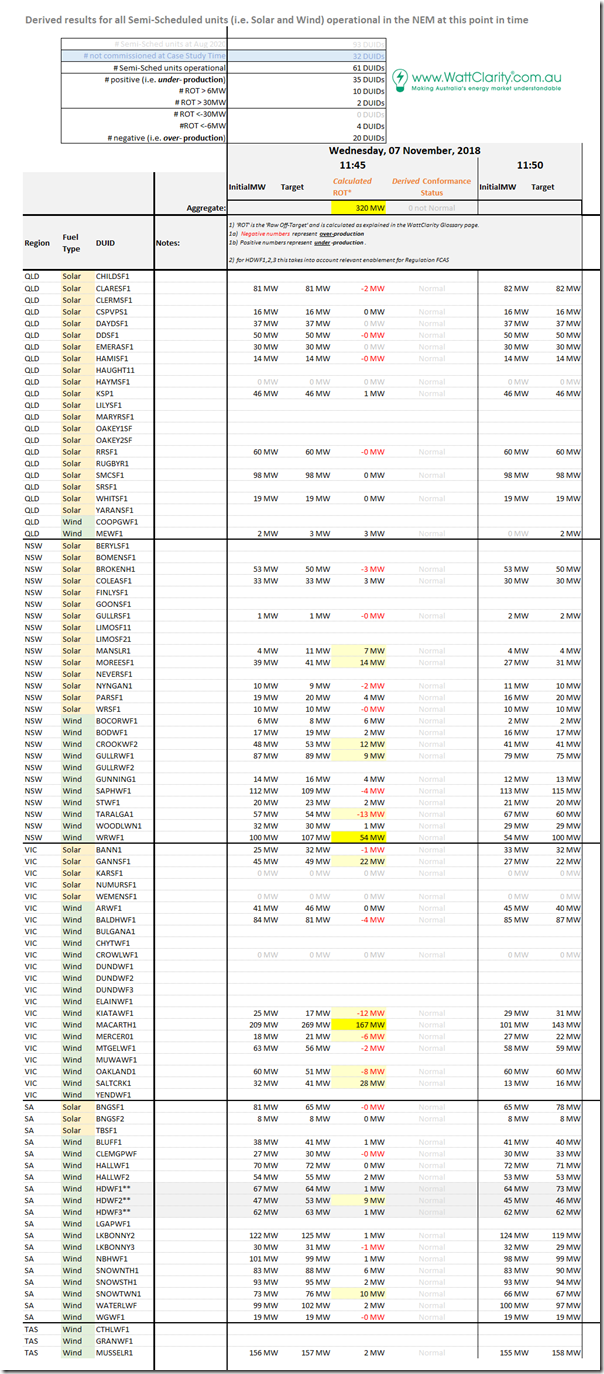
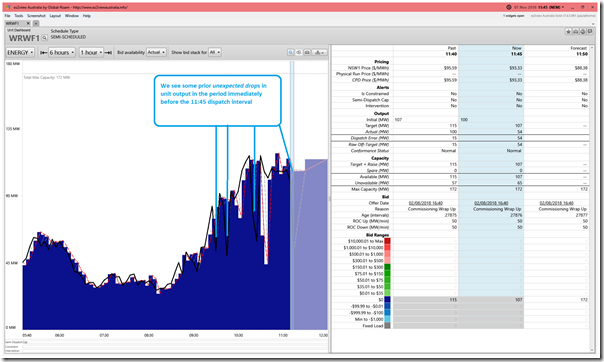
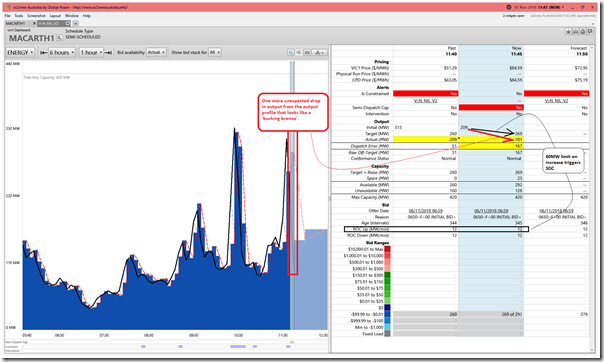
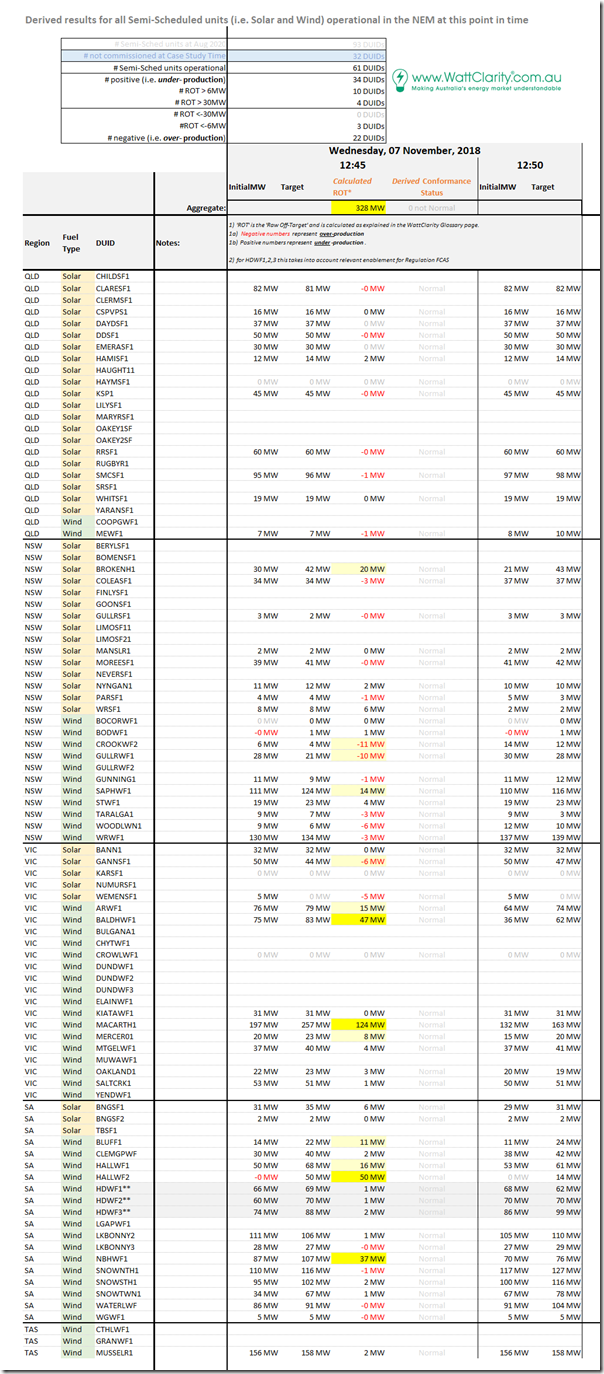
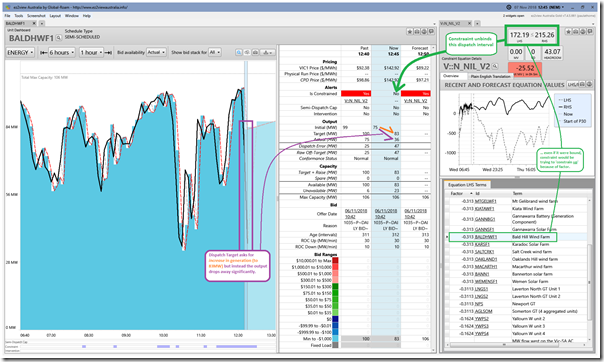
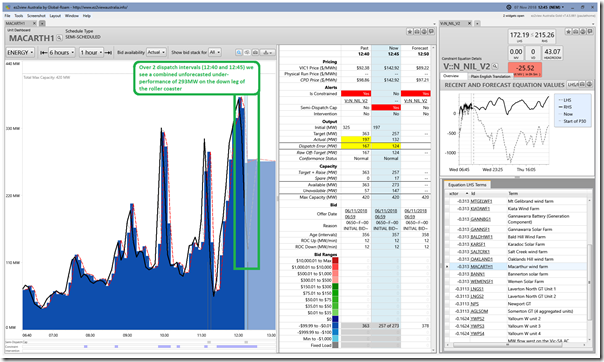
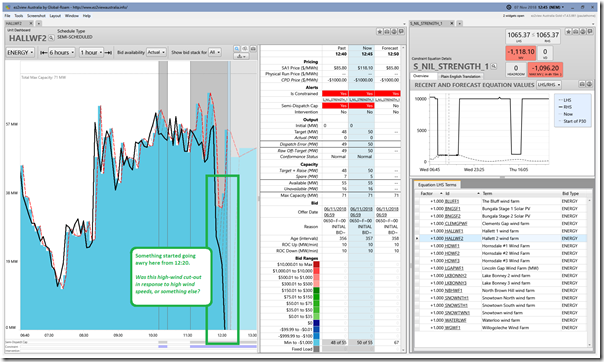
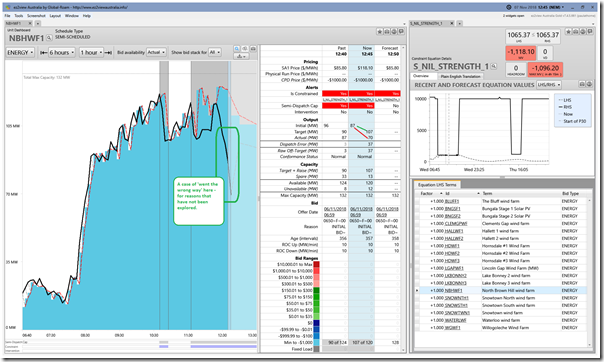
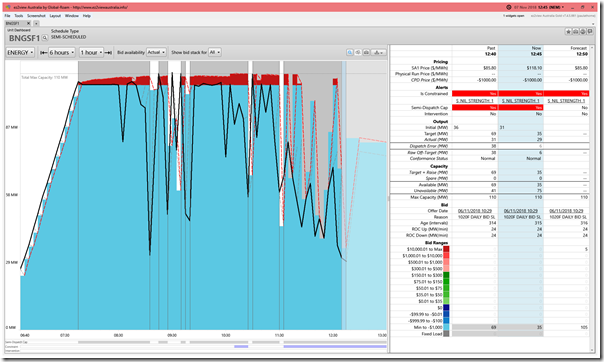
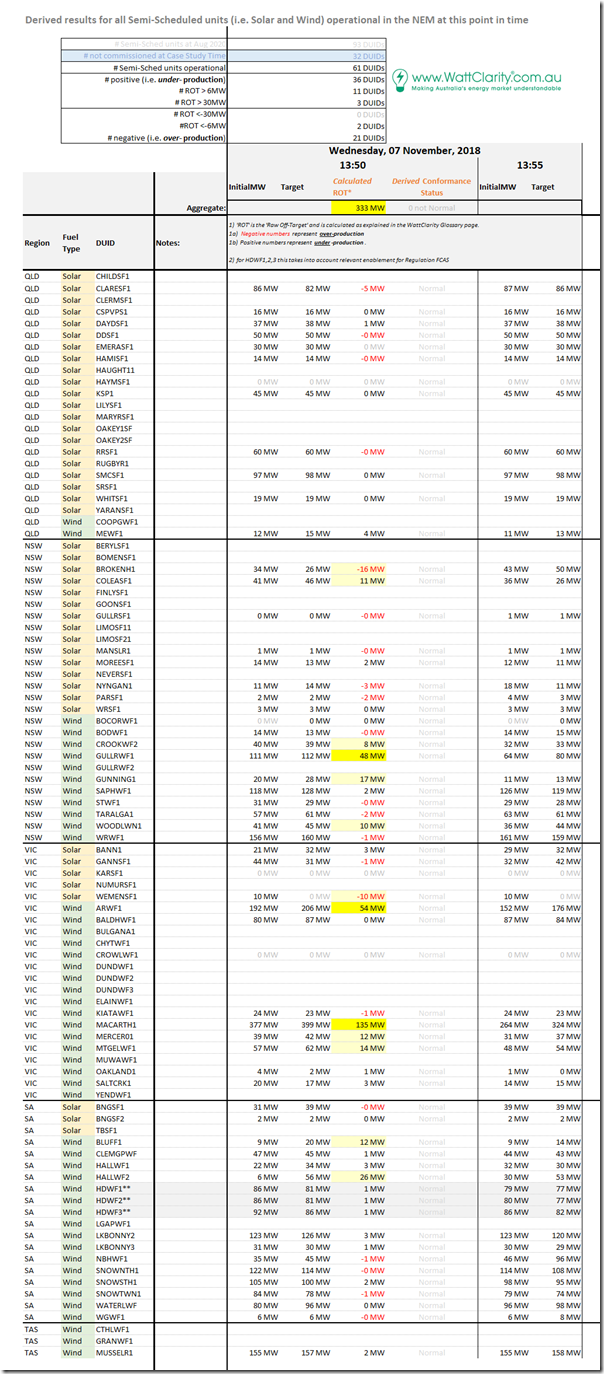
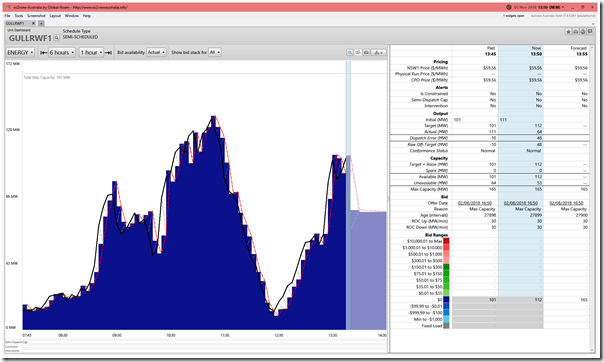
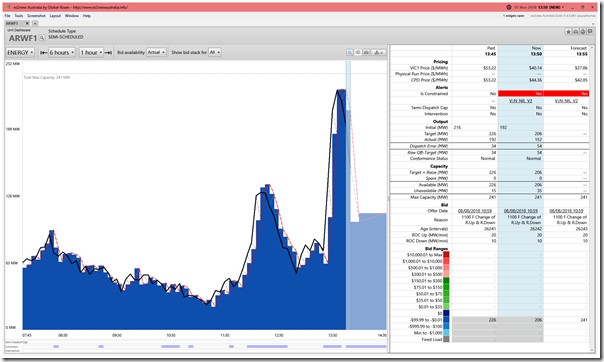
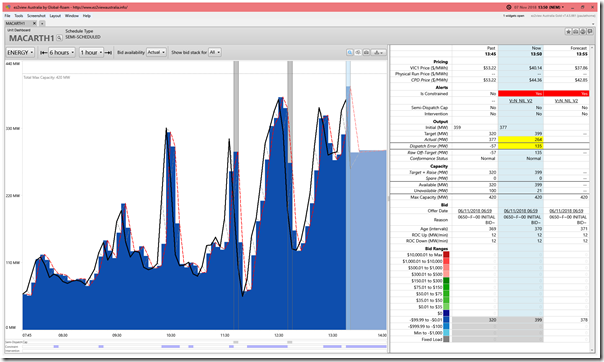
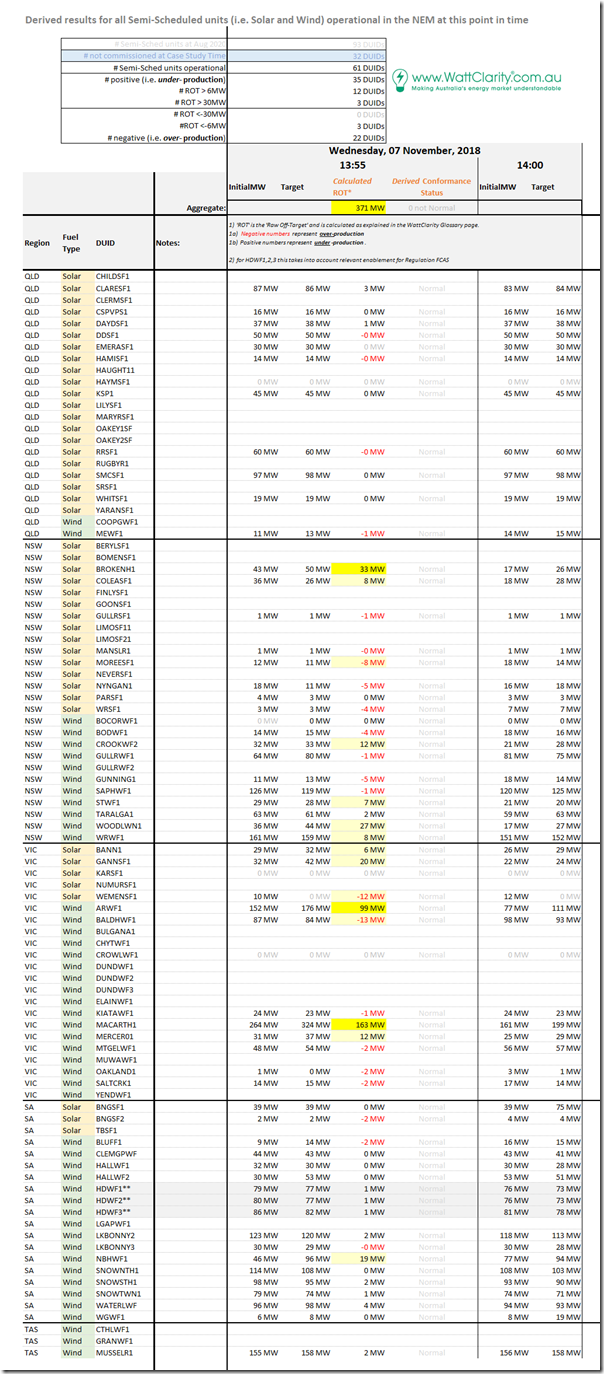
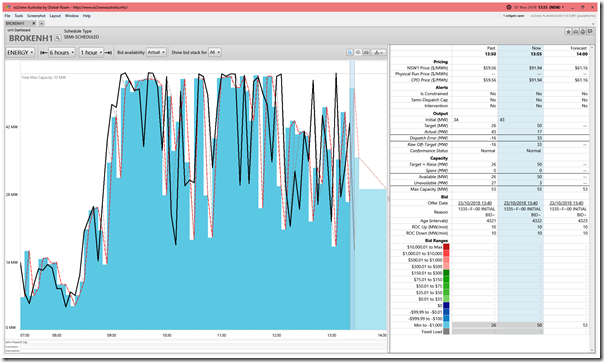
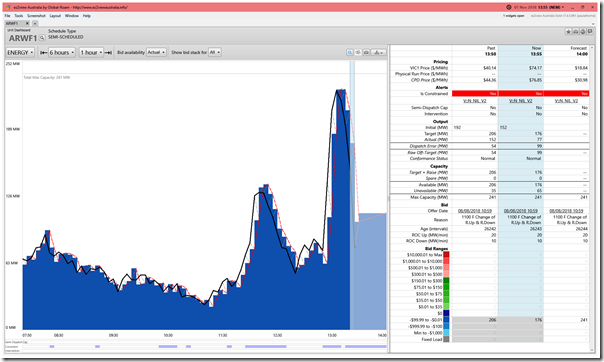
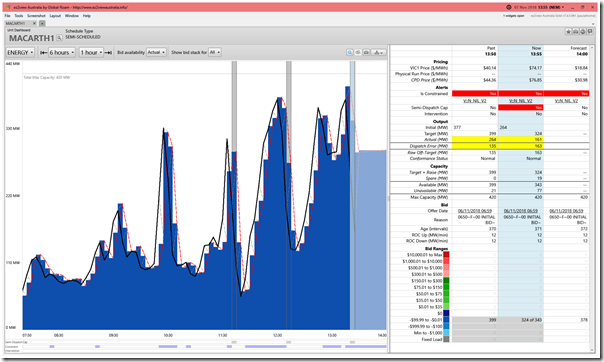
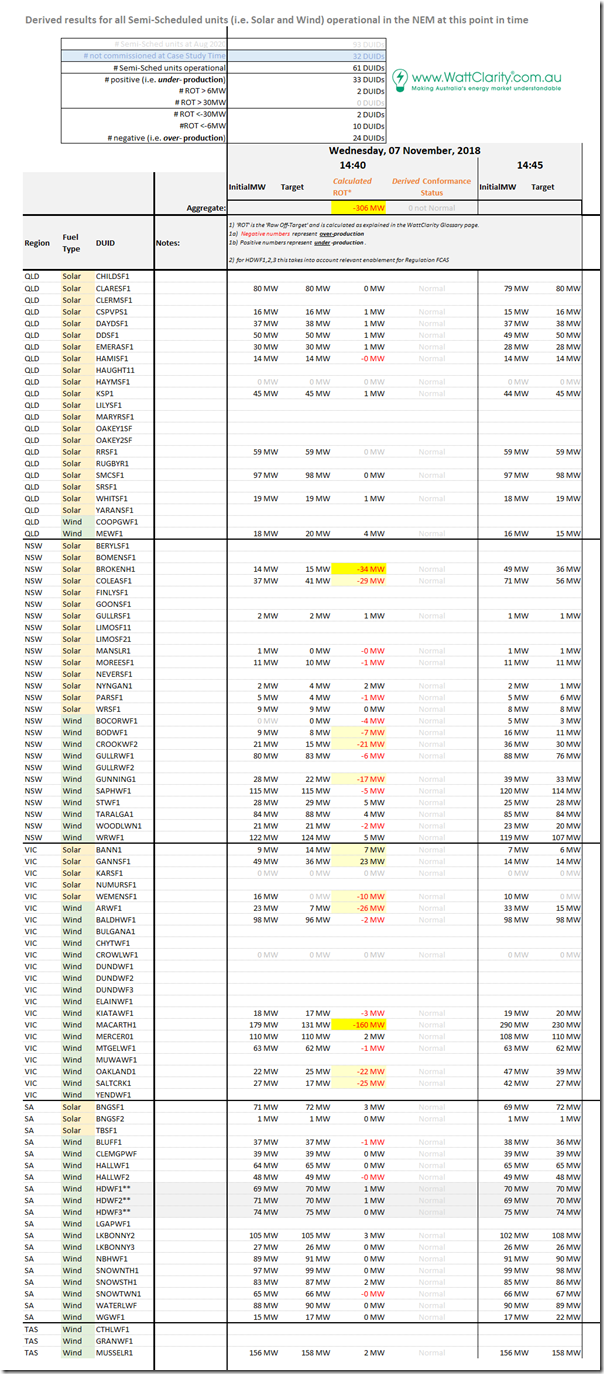
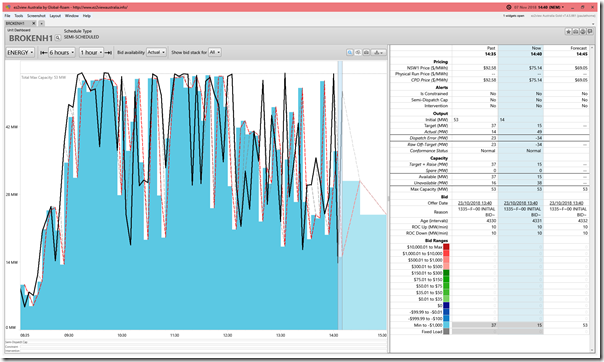
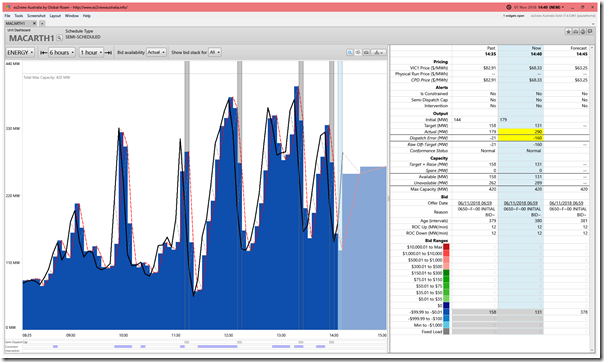
Leave a comment